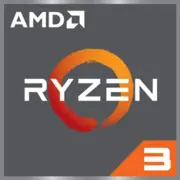AMD Ryzen 3 4300U

AMD Ryzen 3 4300U: A Budget Processor for Everyday Tasks
April 2025
Architecture and Manufacturing Process: Zen 2 in a Compact Format
The AMD Ryzen 3 4300U processor, released in 2020, remains a popular choice for budget laptops due to its balance of price and performance. It is built on the Zen 2 architecture and manufactured using the 7nm TSMC FinFET process, ensuring high energy efficiency.
- 4 cores and 4 threads: Unlike the higher-end Ryzen 5 and 7 models, it does not support simultaneous multithreading (SMT), limiting parallel tasks.
- Frequencies: The base frequency is 2.7 GHz, with a maximum turbo mode frequency of 3.7 GHz.
- Integrated Graphics: The AMD Radeon Graphics (Vega 5) GPU features 5 compute units and can reach frequencies of up to 1500 MHz. For 2025, this is sufficient for basic tasks and light gaming.
- Cache Memory: 4 MB of L3 cache, which is typical for entry-level processors.
The Zen 2 architecture brought a 15% improvement in IPC (instructions per cycle) compared to Zen+, but by 2025, it is already falling behind newer generations like Zen 4 and Intel's 12th generation Core processors.
Power Consumption and TDP: 15 Watts for Thin Laptops
With a TDP of 15W, the Ryzen 3 4300U is ideal for ultrabooks and compact devices.
- Thermal Output: Even under heavy load, the processor rarely overheats, allowing manufacturers to use passive or compact cooling systems.
- Operating Modes: The Precision Boost 2 technology automatically adjusts frequencies based on load and temperature. For instance, when browsing, the frequency can drop to 1.2–1.5 GHz, conserving battery life.
Performance: Modest Results, but Sufficient for Basic Tasks
Geekbench 6 test results (Single Core: 1243, Multi Core: 3363) indicate that the processor handles everyday tasks well but is not designed for professional workloads.
Real-World Scenarios:
- Office Work: Running 10–15 tabs in Chrome, working with Word and Excel documents, and participating in Zoom conferences — all without noticeable lag.
- Multimedia: Watching videos in 4K and basic photo editing in Lightroom. Rendering a 10-minute video in 1080p takes about 25–30 minutes.
- Gaming: Only for undemanding titles — Minecraft (60 FPS on low settings), CS:GO (40–50 FPS), Stardew Valley (stable 60 FPS).
Turbo Mode: During brief heavy loads (e.g., opening a demanding application), the frequency can rise to 3.7 GHz, but after 2–3 minutes, it drops to 2.9–3.1 GHz due to TDP limitations.
Use Cases: Who is the Ryzen 3 4300U Designed For?
This processor is suitable for:
- Students for studying, writing essays, and online courses.
- Office Workers handling documents and emails.
- Users needing an affordable laptop for browsing and streaming.
Not recommended for:
- Professional video editing or 3D modeling.
- Modern games like Cyberpunk 2077 or Elden Ring.
Battery Life: Up to 8 Hours in Moderate Use
Thanks to the 7nm manufacturing process and 15W TDP, laptops with the Ryzen 3 4300U demonstrate good battery life:
- When working with text and a browser: 7–8 hours (battery capacity 45–50 Wh).
- When watching videos: Up to 6 hours.
- Power Saving Technologies: The AMD PowerNow! feature dynamically disables unused cores, while Radeon Chill reduces frame rates in games to conserve battery life.
Comparison with Competitors: Budget Segment 2020–2023
AMD Ryzen 3 5300U (2021):
- Zen 3 architecture, 4 cores/8 threads.
- 20% higher performance in multi-threaded tasks.
- Price of laptops: starting from $450 (Ryzen 3 4300U — from $350).
Intel Core i3-1115G4:
- 2 cores/4 threads, Tiger Lake.
- Better single-threaded performance (+10%), but weaker in multitasking scenarios.
Apple M1 (2020):
- Significantly more powerful (Geekbench 6 Single Core: 2200+), but laptops with M1 start at $700.
Pros and Cons of Ryzen 3 4300U
Strengths:
- Low laptop prices (from $350).
- Good energy efficiency.
- Sufficient performance for basic tasks.
Weaknesses:
- Only 4 threads — limited multitasking capabilities.
- Outdated Zen 2 architecture.
- Weak graphics for gaming beyond 2023.
Laptop Selection Recommendations
1. Device Type: Ultrabooks (Acer Swift 3, Lenovo IdeaPad 5) or budget models (HP 15, ASUS Vivobook).
2. RAM: At least 8 GB (preferably 16 GB for multitasking).
3. Storage: Must have an SSD of 256+ GB.
4. Screen: Full HD (1920×1080) for comfortable usage.
Examples of 2025 Models:
- Lenovo IdeaPad 3 15”: $379 (Ryzen 3 4300U, 8 GB, 256 GB SSD).
- Acer Aspire 5: $399 (version with an IPS screen and keyboard backlighting).
Final Conclusion: Who is the Ryzen 3 4300U Suitable For?
This processor is an excellent choice for those seeking an affordable laptop for everyday tasks: studying, document handling, watching films, and light gaming. Its key advantages are low price, energy efficiency, and sufficient performance for basic needs. However, if you require multitasking capabilities or work with professional applications, it is worth considering newer models (Ryzen 5 5500U, Intel Core i5-1235U).
In 2025, the Ryzen 3 4300U remains relevant in the under $400 segment, particularly for users not chasing the "latest technology."
Basic
CPU Specifications
Memory Specifications
GPU Specifications
Miscellaneous
Benchmarks
Compared to Other CPU
Share in social media
Or Link To Us
<a href="https://cputronic.com/cpu/amd-ryzen-3-4300u" target="_blank">AMD Ryzen 3 4300U</a>